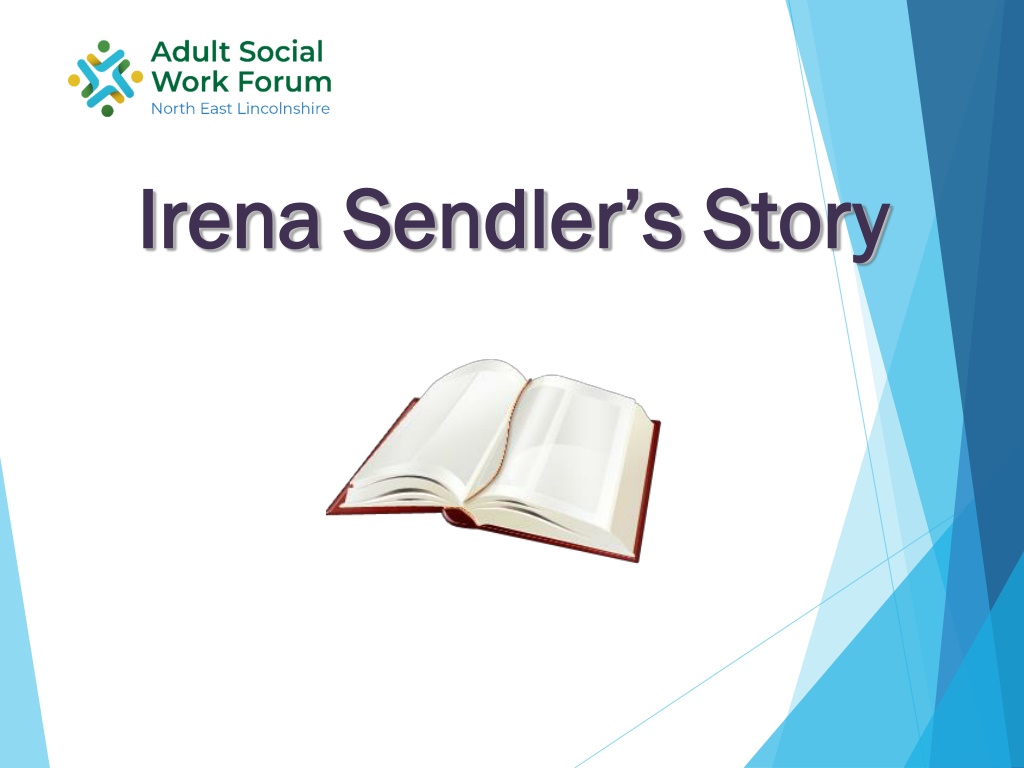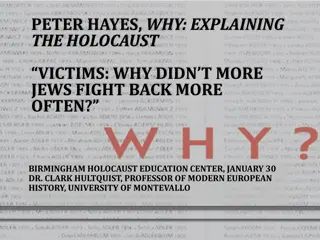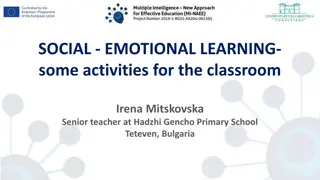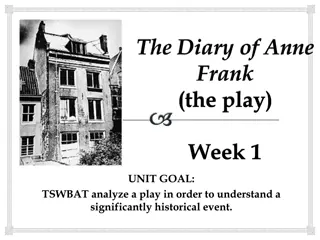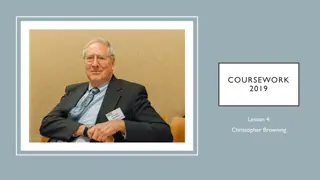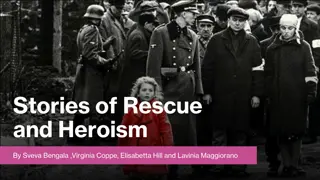Irena Sendler: A Heroine of the Holocaust
Irene Sendlerowa, also known as Irena Sendler, was a Polish social worker who risked her life during the German invasion of Poland in 1939 to save over 2,500 Jewish children from the Warsaw Ghetto. She worked with the Polish underground resistance, smuggling children to safety and providing them with false identities. Her courageous efforts to protect and preserve the lives of innocent children are a true testament to humanity's ability to shine even in the darkest of times.
Download Presentation

Please find below an Image/Link to download the presentation.
The content on the website is provided AS IS for your information and personal use only. It may not be sold, licensed, or shared on other websites without obtaining consent from the author.If you encounter any issues during the download, it is possible that the publisher has removed the file from their server.
You are allowed to download the files provided on this website for personal or commercial use, subject to the condition that they are used lawfully. All files are the property of their respective owners.
The content on the website is provided AS IS for your information and personal use only. It may not be sold, licensed, or shared on other websites without obtaining consent from the author.
E N D
Presentation Transcript
Irena Irena Sendler s Sendler s Story Story
Irene Irene Sendlerowa Sendlerowa (nee Krzyzanowska Krzyzanowska) known as Irena Irena Sendler Sendler (nee ) known as 15/2/1910 12/5/2008 Born 15 miles outside Warsaw, Poland Daughter of one of the first Polish socialists Born into a Catholic Polish family
Social Social Work Work At 17 Irena recalled I wanted to study something concerning social care She studied law at the University of Warsaw She changed to a Humanities Faculty to do Polish studies involving a course in pedagogy NQSW! At a Mother and Child Aid Section
German Invasion German Invasion Germany invaded Poland in 1939 The Nazis herded hundreds of thousands of Jews into the Warsaw Ghetto, where disease, squalor and starvation were common place
Irenas Work Irena s Work Irena was a social worker in the Warsaw Social Welfare Department She gained a pass from the Epidemic Control Department to continue to enter the ghetto She dressed as a nurse when social welfare was banned by the Nazis in order to visit daily to bring food, medicine and clothing to the Jews
Irenas Plan Irena s Plan Irena recognised the peril that Jewish children were in She persuaded reluctant Jewish mothers to part with their children She found Polish families prepared to take in Jewish children and raise them as Christians
Irena and the Resistance Irena and the Resistance As part of the Zegota resistance she worked with the Polish underground They smuggled children out of the ghetto in body bags, buried in goods carts, in sacks of potatoes, and even in coffins and in a mechanics toolbox She gave children false identities She carefully noted original names and new identities in coded form She placed this information in jars and buried the jars beneath an apple tree She smuggled 2,500 children to safety
Grieving Parents Grieving Parents Can you guarantee they will live? asked distraught parents. Irena could only guarantee they would die if they stayed. In my dreams Irena said, I still hear the cries when they left their parents
The Price She Paid The Price She Paid In 1943 Irena was arrested by the Gestapo She was severely tortured, and sentenced to death as she refused to betray her associates or any of the children in hiding Zegota saved her by bribing German guards on the way to her execution She was left in the woods, unconscious and with broken arms and legs For the rest of her life she had mobility problems because of this
After the War After the War After the war she dug up the jars and used the notes to track down the children she placed with adoptive families and to reunite them with relatives scattered across Europe Most lost their families during the Holocaust in Nazi death camps The children had known her only by her code name Jolanta. But years later, after she was honored for her wartime work, her picture appeared in the newspaper. A man, a painter, telephoned me, said Sendler, I remember your face, he said. It was you who took me out of the ghetto. I had many calls like that!
Awards Awards 1965 1965 Yad Vashem the Holocaust Martyrs and Heroes. Remembrance Authority in Jerusalem recognises Irena as a righteous Gentile 1983 1983 Yad Vashem plants a tree in her honour 1991 1991 Irena was made an honorary citizen of Israel 2003 2003 Irena receives a letter from the Pope recognising her work and was awarded Poland s highest honour, the Order of the White Eagle 2004 2004 Irena is recognised by President of Poland 2007 2007 Irena is nominated for the Nobel Peace Prize by the Polish president he referred to her as a great heroine who can be justly named for the Nobel Peace Prize. She deserves great respect from our whole nation These are just some of the awards she received
Irena said I was taught that if Irena said I was taught that if you can see a person you can see a person drowning, you must jump into drowning, you must jump into the water to save them, the water to save them, whether you can swim or not whether you can swim or not Irena died on 12 May 2008 at the age of 98 in a Warsaw Nursing Home cared for by one of the children that she smuggled out of the ghetto. She had three children, two sons who both died, and a daughter.
